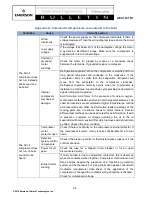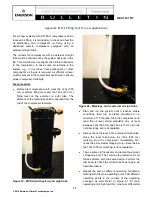
© 2018 Emerson Climate Technologies, Inc.
18
AE4-1431 R1
5.3. Charging procedure
In any case avoid air/R290 mixture in the refrigeration
system. Make sure that the system is filled with pure
R290.
Low suction pressure operation! Compressor
damage!
Do not operate compressor with a restricted
suction. Do not operate with the low-pressure limiter
bridged. Do not operate at pressures that are not
allowed by the operating envelope. Allowing the suction
pressure to drop below the envelope limit for more than
a few seconds may overheat scrolls and cause early
drive bearing and moving parts damage.
For this dedicated system with refrigerant charges
below 150 grams, the entire refrigerant quantity can be
charged from the bottle by means of pressure
difference. The charging point is typically on high
pressure side, in the proximity of the filter drier.
5.4. Preliminary checks
– Pre-starting
•
Visual check of the electrics, wiring, fuses etc.
•
Cable glands in good state, all electrical
connections well connected and terminal dome
cover closed to ensure corresponding IP protection
for European units and compressor molded plug
fully seated and clipped in place for US units.
•
Visual check of the plant for leaks, loose component
parts such as TXV bulbs or solenoid valve coil,
loose wires in electrical installation, etc.
•
Functional test of LP switch
•
Check setting and operation of all safety features
and protection devices
•
All valves in the correct running position
•
Correctly charged with refrigerant
•
Compressor electrical auxiliary switch location and
position
5.5. Rotation direction
Scroll compressors are directional dependent; i.e. they
will compress in one rotational direction only. Three
phase scrolls will rotate in either direction depending on
power phasing. Since there is a 50/50 chance of
connected power being “backwards”, contractors should
be warned of this. Appropriate instructions or notices
should be provided by the OEM.
Verification of proper rotation can be made by observing
that the suction pressure drops and the discharge
pressure rises when the compressor is energized.
There is no negative impact on durability caused by
operating three-phase Scroll compressors in the
reversed direction for a short period of time (under one
hour) but oil may be lost. Oil loss can be prevented
during reverse rotation if the tubing is routed at least
6”
above the compressor. After several minutes of
operation in reverse, the compressor protection system
will trip due to high motor temperature. The operator will
notice a lack of cooling or heating. However, if allowed
to repeatedly restart and run in reverse without
correcting the situation, the compressor will be
permanently damaged.
All three-phase scroll compressors are identically wired
internally. Therefore, once the correct phasing is
determined for a specific system or installation,
connecting properly phased power leads to the
identified compressor terminals will ensure proper
rotation direction.
5.6. Starting sound
During the very brief start-up, a clicking sound is
audible, resulting from initial contacting of the spirals
and is normal. Due to the design of the Copeland Scroll
compressors, the internal compression components
always start unloaded even if system pressures are not
balanced. In addition, since internal compressor
pressures are always balanced at start-up, low-voltage
starting characteristics are excellent for Copeland Scroll
compressors.
5.7. Deep vacuum operation
Vacuum operation! Compressor damage!
Copeland
Scroll compressors should never be used to evacuate
refrigeration or air-conditioning systems.
CAUTION
CAUTION












































